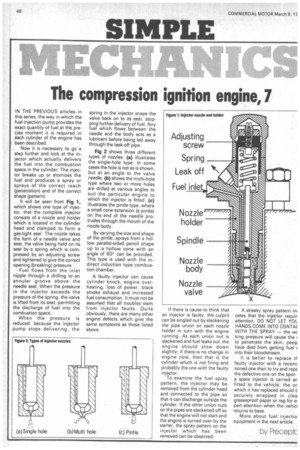The compression ignition engine, 7
Page 50

If you've noticed an error in this article please click here to report it so we can fix it.
IN THE PREVIOUS articles in this series, the way in which the fuel injection pump provides the exact quantity of fuel at the precise moment it is required in each cylinder of the engine has been described.
Now it is necessary to go a step further and look at the injector which actually delivers the fuel into the combustion space in the cylinder. The injector breaks up or atomizes the fuel and produces a spray or sprays of the correct reach (penetration) and of the correct shape (pattern).
It will be seen from Fig 1, which shows one type of injector, that the complete injector consists of a nozzle and holder which is located in the cylinder head and clamped to form a gas-tight seal. The nozzle takes the form of a needle valve and seat, the valve being held on its seat by a spring which is compressed by an adjusting screw and tightened to give the correct opening (breaking) pressure.
Fuel flows from the inlet nipple through a drilling to an annular groove above the needle seat. When the pressure in the injector exceeds the pressure of the spring, the valve is lifted from its seat, permitting the discharge of fuel into the combustion space.
When the pressure is reduced, because the injector pump stops delivering, the spring in the injector snaps the valve back on to its seat, stopping further delivery of fuel. Any fuel which flows between the needle and the body acts as a lubricant before being led away through the leak-off pipe.
Fig 2 shows three different types of nozzles. (a) illustrates the single-hole type. In some cases the hole is not as is shown, but at an angle to the valve needle. (b) shows the multi-hole type where two or more holes are drilled at various angles to suit the particular engine to which the injector is fitted. (c) illustrates the pintle type, where a small cone extension (a pintle) on the end of the needle protrudes through the mouth of the nozzle body.
By varying the size and shape of the pintle, sprays from a hollow parallel-sided pencil shape up to a hollow cone with an angle of 60° can be provided. This type is used with the indirect induction type combustion chamber.
A faulty injector can cause cylinder knock, engine overheating, loss of power, black smoke exhaust and increased fuel consumption. It must not be assumed that all troubles stem from injector faults. Quite obviously, there are many other engine defects which give the same symptoms as those listed above. If there is cause to think that an injector is faulty, the culprit can be singled out by slackening the pipe union on each nozzle holder in turn with the engine running. As each union nut is slackened and fuel leaks out, the engine should slow down slightly: if there is no change in engine note, then that is the cylinder which is not firing and probably the one with the faulty injector.
To examine the fuel spray pattern, the injector may be removed from the cylinder head and connected to the pipe so that it can discharge outside the cylinder. If the other union nuts on the pipes are slackened off so that the engine will not start and the engine is turned over by the starter, the spray pattern on the injector which has been removed can be observed. A streaky spray pattern in cates that the injector requir attention. DO NOT LET YOL HANDS COME INTO CONTA( WITH THE SPRAY — the wc king pressure will cause the to penetrate the skin; peop have died from getting fuel into their bloodstream.
It is better to replace tF faulty injector with a reconc tioned one than to try and reps the defective one on the spot. a spare Injector is carried an fitted to the vehicle, the or which it has replaced should t securely wrapped in clea greaseproof paper or rag for a pert attention when the vehicl returns to base.
More about fuel injectio equipment in the next article.
by Precept












































































































